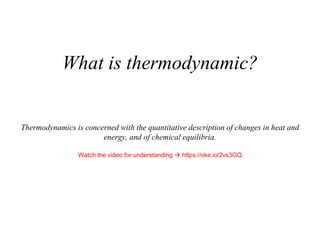
Understanding Thermodynamics Concepts
- 1. What is thermodynamic? Thermodynamics is concerned with the quantitative description of changes in heat and energy, and of chemical equilibria. Watch the video for understanding https://oke.io/2vs3GQ
- 2. What information does is provides? Watch the video for understanding https://oke.io/2vs3GQ
- 3. 1. Equilibrium positions in reactions 2. feasibility of a reaction under a given circumstances. 3. insight into the nature of forces responsible for bonding between molecules, enzymatic catalysis, functioning of DNA and RNA
- 4. What it fails to say? it fails to give information on the rate of the reactions let alone if the reactions will occur within a given period of time.
- 5. Basic concepts Watch the video for understanding https://oke.io/2vs3GQ
- 6. 1. System 2. Open system 3. Closed system 4. Isolated (adiabatic) system 5. State function
- 7. Should living organisms be considered as open, closed or isolated system? Watch the video for understanding https://oke.io/2vs3GQ
- 9. Laws of thermodynamics Watch the video for understanding https://oke.io/2vs3GQ
- 10. First law of thermodynamics This states that the total energy of the universe does not change. However, the forms of energy can change. ∆E = q - W
- 11. 1. Negative q value indicates that heat has been emitted from the system 2. Positive q value indicates that heat has been absorbed by the system 3. Negative W value connotes that work has been done on the system by the surrounding 4. Positive W value connotes that work has be done by the system on the surrounding What dictates if ∆q and ∆W are positive or negative?
- 12. ➢ When the same reaction is performed at constant pressure, the reaction vessel will do work on the surroundings. Thus ∆E=q-W Where, W=P∆V ➢ When the initial and final temperatures are essentially equal as obtained in biological systems ∆V= ∆nRT/P Thus W= ∆nRT ➢ By rearranging the above equation, the amount of heat released under pressure under constant pressure is giving by q= ∆E+W q=∆E+P∆V q=∆E+ ∆nRT Δn = change in moles of gas per mole of substance oxidized (or reacted) R = gas constant; T = absolute temperature
- 13. Enthalpy Since all biological reactions occur at constant pressure and temperature, the state function of reactions defined to account for the heat evolved or absorbed by a system is called enthalpy and it is given by the symbol H. The changes in enthalpy are related to changes in free energy with the following equation: ∆H=∆E+P∆V
- 14. Biochemical reactions in biological systems does not produce gas since they occur largely in excess fluid. Thus V is extremely small, the product P V is very small too, making E and H values nearly equivalent in biological reactions.
- 15. Example The changes in internal energy ΔE for the total oxidation of glucose (C6H12O6) and stearic acid (C18H36O2) at 310 K (37oC) are −2.9 x 103 kJmol−1 and −11.36 x 103 kJ mol−1, respectively. (a) Calculate ΔH for these reactions. (b) Which substance is more likely to be useful for energy storage in the body?
- 16. For glucose, the reaction is C6H12O6 + 6O2 6CO2 + 6H2O In this case, there is no volume change i.e. 6CO2 - 6O2 = 0 (both O2 and CO2 are gases at 310K). Hence H=E+W H=E+PΔV V = 0 H = E H = -2.9 x 103 kJ/mol
- 17. Second law of thermodynamics This states that the universe (all systems) tends to the greatest degree of randomization or disorderliness. ΔS ≥ Δq/T = applies to reversible reactions inequality denotes irreversible reactions
- 18. For reversible reaction (processes) ΔS (system + surrounding)= 0 For real (non) reversible processes ΔS>0 For an isothermal reversible reaction the change in entropy can be reduced to the term: ΔS = ΔH/T
- 19. Free energy Watch the video for understanding https://oke.io/2vs3GQ
- 20. To evaluate the course of a reaction and taking into accounts of first and second laws of thermodynamics, Gibbs defined the term free energy as as measure of how far a reaction is from equilibrium
- 21. To evaluate the course of a reaction and taking into accounts of first and second laws of thermodynamics, Gibbs defined the term free energy as a measure of how far a reaction is from equilibrium designated as G. G represents the amount of work that can be done by a chemical reaction.
- 22. Second law of thermodynamics indicates that a process will occur spontaneously if Δq < T x ΔS. For a process occurring at constant temperature and pressure Δq = ΔH. Thus, for a spontaneous process ΔH – TΔS < 0 The quantity ΔH – TΔS is called ΔG and if a process occur spontaneously, ΔG < 0 G= Gibb’s Free Energy ΔG = ΔH – TΔS
- 23. Third law of thermodynamics This law asserts that as thermodynamic temperature, T approaches O K, the entropy S also approaches zero for perfect crystalline substances.